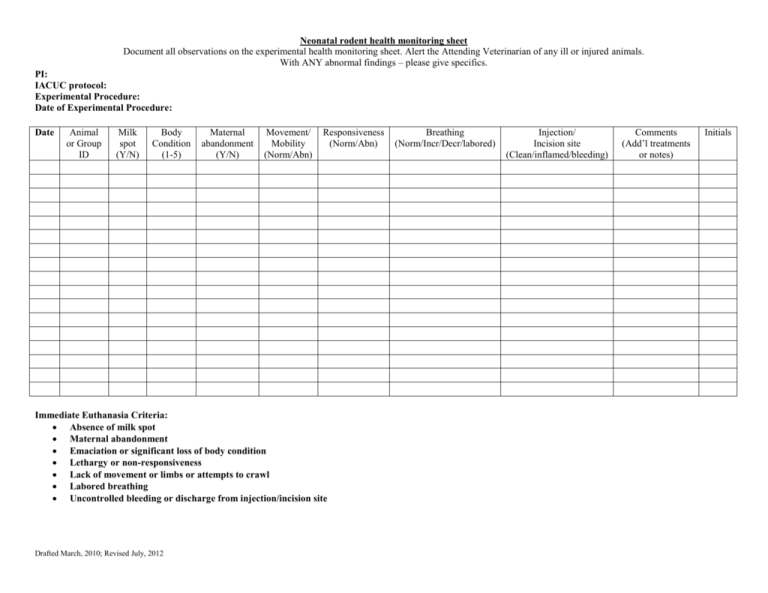Rodent Health Monitoring Sheet
advertisement

Neonatal rodent health monitoring sheet Document all observations on the experimental health monitoring sheet. Alert the Attending Veterinarian of any ill or injured animals. With ANY abnormal findings – please give specifics. PI: IACUC protocol: Experimental Procedure: Date of Experimental Procedure: Date Animal or Group ID Milk spot (Y/N) Body Condition (1-5) Maternal abandonment (Y/N) Movement/ Mobility (Norm/Abn) Responsiveness (Norm/Abn) Immediate Euthanasia Criteria: Absence of milk spot Maternal abandonment Emaciation or significant loss of body condition Lethargy or non-responsiveness Lack of movement or limbs or attempts to crawl Labored breathing Uncontrolled bleeding or discharge from injection/incision site Drafted March, 2010; Revised July, 2012 Breathing (Norm/Incr/Decr/labored) Injection/ Incision site (Clean/inflamed/bleeding) Comments (Add’l treatments or notes) Initials Neonatal rodent health monitoring sheet Document all observations on the experimental health monitoring sheet. Alert the Attending Veterinarian of any ill or injured animals. With ANY abnormal findings – please give specifics. Guidelines for monitoring parameters: Milk Spot: Neonatal rodents are hairless, which allows for observation of milk in the stomach, commonly referred to as the milk spot. The milk spot will be an off white to pale yellow area on the left side of the abdomen. Once a dam finishes delivering, all pups are gathered and encouraged to nurse. If a milk spot is not visible within 24 hours of birth, the pup is not nursing and will decline very rapidly. Body Condition: To assess body condition the animal should be observed for the prominence of the vertebrae and the hip bones. Animals in normal body condition have barely visible vertebrae and hip bones. Animals that are thin or emaciated have very prominent vertebrae and hip bones. Neonates that become ill will lose body condition very quickly. BCS1: If a rat or mouse is found in this condition, euthanasia must be performed. BCS2: At this stage, as the animal progresses from BCS3 to BCS2, more careful observation is warranted. Supportive care (moistened food on the cage floor, plus a water source, plus other calorie sources – such as sunflower seeds or cereal) should be initiated, if it would not interfere with the outcome of the experiment. If data can be obtained once the rodent has reached this point, euthanasia is required. BCS3: This is optimal rodent body condition. BCS4: The animal is beginning to gain weight. BCS5: The animal is obese. The feeding of a lower-fat, lower-protein chow may be considered at this point for optimal health. Maternal abandonment: Dams will reject pups for a variety of reasons, including illness of the pup or abnormal odors on the pup from handling. Once a procedure has been completed on the pup and it is returned to the dam, it must be observed closely to ensure the dam will continue to care for the pup. Abandoned pups will not have a milk spot and will be expelled from the nest. An abandoned pup that cannot be fostered onto another dam will deteriorate quickly and should be euthanized for humane reasons. Mobility: Neonates can crawl immediately after birth, but for the first few days will generally only crawl to return to the nest or reach the dam. Within the nest, neonates can be observed moving their limbs and wiggling. If the pups cannot move all four limbs, they may be either too weak to move or paralyzed and should be treated or euthanized immediately. Drafted March, 2010; Revised July, 2012 Neonatal rodent health monitoring sheet Document all observations on the experimental health monitoring sheet. Alert the Attending Veterinarian of any ill or injured animals. With ANY abnormal findings – please give specifics. Responsiveness: Healthy rodents are easily roused if sleeping and will respond immediately to noises or touching during observation. Minimal responsiveness or exaggerated responsiveness to stimuli are indicators of illness and usually require immediate euthanasia. Neonates typically appear a bit sluggish and uncoordinated compared to adults, but they will respond immediately to touch. Breathing: Breathing should be smooth and effortless, with the mouth closed and no discharge from the nose. Labored breathing with exaggerated abdominal movement, open mouth breathing, and discharge from the nose are indicators of respiratory distress and must be addressed immediately. Injection/Incision site: Injection and incision sites should be monitored for bleeding, discharge, swelling, and redness. Incisions from surgical procedures should be monitored daily for at least 1 week after the procedure to ensure adequate closure and healing. Pain: Pain is difficult to assess in neonates, but an absence of a milk spot, lethargy, and reduced responsiveness could indicate pain and should be addressed. Drafted March, 2010; Revised July, 2012







